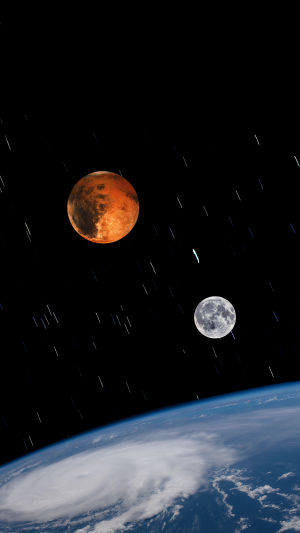Mars is one of the brightest planets we can see from Earth, glowing with a deep reddish color that catches our attention. Its fiery appearance makes us wonder if fire actually exists there, but in reality, Mars has no flames at all.
So why does this “Red Planet” look so red, and what makes it such a fascinating mystery for us?
<h3>Why Mars Looks Red</h3>
Mars’ surface appears bright red, almost like it’s been scorched by fire. But this color isn’t from actual flames. The secret lies in the soil. Mars is rich in iron, and over billions of years, this iron has reacted with the tiny amount of oxygen in the thin Martian atmosphere, forming iron oxide—basically rust. This rust gives Mars its reddish or orange-red appearance, making it stand out in the night sky as a fiery-looking planet, even though it’s cold and lifeless.
<h3>A Lonely, Barren Landscape</h3>
Unlike Earth’s green forests and deep blue oceans, Mars looks stark and empty. Its surface has almost no plants and barely any liquid water, giving the illusion that it’s always surrounded by fire. Mars got its name from a figure in Roman mythology, which suits its striking red color perfectly. But the “fire” we imagine is just in our minds.
<h3>No Fire on Mars</h3>
Despite its fiery color, Mars is far too cold for flames. Temperatures can drop as low as -125°C and rarely rise above 20°C. Flames require much higher temperatures and oxygen to burn. Mars simply doesn’t have the right conditions for fire. Its atmosphere is extremely thin—less than 1% of Earth’s air pressure—so even if flammable material existed on the surface, it couldn’t ignite naturally.
<h3>A Harsh, Freezing Climate</h3>
Mars’ atmosphere is mostly carbon dioxide, about 95%, with tiny amounts of nitrogen, argon, and oxygen. Unlike Earth, Mars is extremely dry, with almost no liquid water. What water exists is mostly frozen, especially near the poles. Without a thick atmosphere to catch heat, average temperatures hover around -60°C, and polar regions can reach -125°C. On top of that, Mars’ surface is constantly bombarded by solar wind, making conditions even harsher.
<h3>Martian Weather Extremes</h3>
Mars has some of the wildest weather in the solar system. One striking feature is its dust storms, which can cover the entire planet for months. With no oceans to provide humidity, clouds are rare, but winds can reach hundreds of kilometers per hour, lifting fine dust and creating near-total obscuration. Mars also experiences polar day and night, just like Earth’s seasons, where the poles can have continuous daylight in summer and long darkness in winter, adding to its harsh environment.
<h3>Hidden Water Secrets</h3>
Despite its dry appearance, Mars isn’t completely devoid of water. Scientists have found large amounts of ice, especially at the south pole, and there could even be liquid water underground. This discovery gives hope for future exploration and potential human missions, as water is essential for any colony.
<h3>Exploring Mars Today</h3>
NASA’s rovers, Curiosity and Perseverance, are currently exploring Mars’ surface, studying its geology, and searching for signs of underground water. If we can locate stable water sources, the dream of humans living on Mars could become more realistic. However, building a base would still be a monumental challenge given the extreme cold, scarce water, and violent dust storms.
<h3>Looking Beyond the Red</h3>
Mars looks red and mysterious, but it’s actually a cold, unforgiving planet. Still, its strange beauty and challenges keep us fascinated and motivated to explore. So, Lykkers, do you think humans could ever live there? If we were to build a base, what do you think would be the hardest part—surviving the freezing climate, finding water, or facing massive dust storms? Keep looking up at Mars, and imagine all the secrets it still holds for us.





